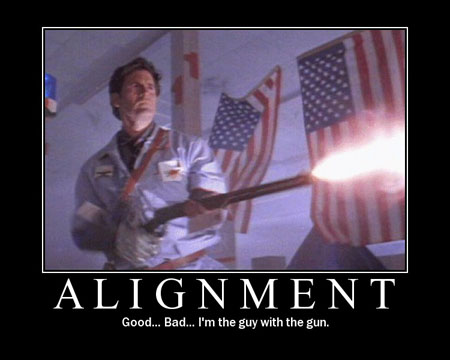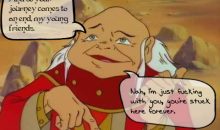Reclaiming Alignment
As I’ve referenced a few times in past articles, I run a DnD game. I set the game in Darksun, then reskinned some 4E modules to suit the story I wanted to tell. In one of the modules, the characters found themselves in an underground city called The Seven Pillared Hall (the module was Thunderspire Mountain). One of the factions in the Seven Pillared Hall was a group of duergar (evil dwarves) that were operating a legitimate business as a front for their illicit activities. Defeating the main duergar fortress is one of the main goalposts along the way to finishing up the module, so naturally at one point the characters found themselves in the duergar’s shop asking some questions. I wanted to steer the adventure down the road that it was supposed to naturally follow, so when the players poked around in places they shouldn’t have, I let them discover the duergar hiding a dead body. As naturally follows such an event, initiative was rolled and combat was had. After the duergar were defeated, the players searched around and found a passage leading back to the main duergar fortress, which they they conquered and ransacked. All was well in the world of Dungeons and Dragons.
But, because I was born under a bad sign, I wasn’t content to let things simply sit like that. After the game we had a discussion about the moral and realistic ramifications of their actions. Taken outside of a DnD context, a group of vigilantes discovered what appeared to be a citizen of the Seven Pillared Hall covering up a murder. Instead of fetching the guards, those vigilantes then proceeded to murder everyone else in the shop. They then found out where their victims had lived and proceeded to invade their home and murder all of their families.
Since the characters were all from the Darksun universe, notorious for its brutality, their Road Warrior approach to justice made sense (even if the players were just responding in classic DnD fashion, and behaving as I’d intended as the GM). However, I had cast the Seven Pillared Hall as an outpost of a forgotten civilized age. The citizens there had a morality much closer to our own modern sense of ethics. This allowed me to have the city respond as we would respond to people behaving like DnD characters in real life – with horror.
This opened the door for us to have some very intense conversations about the nature of morality and its applications in the world I’d created. As it’s used in the books, alignment is probably the worst morality system in any rpg I’ve played. As a rule, I don’t make players take alignments at all (with the exception of paladins). In my mind, actually subscribing to an alignment enough to put it on a character sheet means that your character could easily be described as a zealot. What we discovered in those conversations, however, is that alignment is a great way to measure a character’s aspirations and goals. People generally can’t be described as “chaotic good” or “lawful evil” – people are far more complex than that. But people DO have an idealized version of the way they believe they SHOULD behave, for which alignment does a good job of acting as a compass.
Once you establish alignment as an aspiration rather than a restriction on a character, the roleplay and thought processes of playing that character become a lot more interesting. The conversation shifts from “Would your character do that?” to “What does that action mean for your character’s vision of themselves?” The first question is just an argument waiting to happen at every DnD table out there, while the second adds an entirely new layer to characters. It allows for actual character development, and the realization of shifting priorities and emotional needs for a character over time. Goals become more than “Kill dragon, take treasure”, and the game rises up to the next level of Maslow’s hierarchy.




